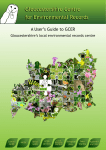Download User Guide to Open Space Standards
Transcript
North Norfolk District Council Local Development Framework Interim Practice Guide to Core Strategy Open Space Standards September 2008 2 Practice Guide to Open Space Standards Contents: 1. Introduction 2. Policy context 3. Definitions of open space / types of open space provision 4. North Norfolk Open space standards 5. Applying the open space requirements to new developments 6. Additional details for provision of open space Appendices: 1. North Norfolk Core Strategy Policies CT2 and SS4 2. Public parks hierarchy and description of types of open space 3. Step by step guide for determining what type of provision may be required 4. Existing open space provision in North Norfolk 5. Distribution of public park open space by Ward Annex 1 - Maps: 1.1 to 1.6: Pedestrian accessibility to small local parks for Principal and Secondary Settlements 2.1 to 2.3: Quality of existing open spaces 3.1 to 3.6: Scope for improvements in existing open spaces 4.1: drive time catchments from allotment provision Page 4 5 7 9 11 16 17 19 21 23 28 29 3 1. INTRODUCTION The provision of public open space and facilities for sport and recreation underpins people’s quality of life. Where new development occurs it is important that sufficient open space, sport and recreation provision is made to meet the needs arising from the new development. This should ensure that opportunities for play, relaxation and enjoyment are provided as well as providing green spaces for wildlife and to allow new development ‘room to breathe’. Open space also forms an important element of ‘sustainable development’ and can encourage people to walk and cycle by providing links to other areas. It is important that open space s included within a site master-plan from the outset and is not seen as a bolt-on extra at the end. This Guide is intended to provide advice on the implementation of Policy CT2, developer contributions, and the Open Space standards contained in the North Norfolk Core Strategy incorporating development control policies Development Plan Document. This practice guide is interim advice, to provide guidance on how to use the Core Strategy open space standards, in advance of the Council preparing a SPD on Planning Obligations, which will include more detail on all aspects of developer contributions. The SPD will be subject to public consultation before adoption by the Council. 4 2. POLICY CONTEXT National Policy The Government’s approach to open space, sport and recreation in conjunction with new development is set out in Planning Policy Guidance 17 (PPG17). It states that …Local authorities should ensure that provision is made for local sports and recreational facilities (either through an increase in the number of facilities or through improvements to existing facilities) where planning permission is granted for new developments (especially housing) (para 23). Local authorities should also seek opportunities to improve the local open space network….(para 24). Local authorities will be justified in seeking planning obligations where the quantity or quality of provision is inadequate or under threat, or where new development increases local needs. (para 33) The Government recognises the importance of open space in achieving healthy living environments and Planning Policy Statement 3 on Housing requires high quality housing that provides, or enables good access to, community and green and open amenity and recreational space (including play space) as well as private outdoor space such as residential gardens. (para 16) It is a well established principle that development should contribute to the additional demands placed on local services, open space and infrastructure that result from it, and further guidance on planning obligations is provided in ODPM Circular 05/2005 and the DCLG Planning Obligations Practice Guide (July 2006). Local Policy North Norfolk’s approach to protecting existing open space and seeking new open space to serve the needs of new development is set out in the Core Strategy incorporating development control policies Development Plan Document (DPD). This sets out the policy context that planning applications across the district will be determined in accordance with. Important open spaces within the selected settlements are designated on the Proposals Map and Policy CT1 seeks to protect these areas from development that may harm their open character or recreation function. Core Strategy Policy SS4 requires that new development incorporates open space and high quality landscaping to provide attractive, beneficial environments for occupants and wildlife. Policy CT2 sets out the requirement for schemes of 10 or more dwellings, and substantial commercial development (over 1,000m2) to make improvements to open space where there is not sufficient capacity to meet the needs of the development. The Open Space Standards that provide the detail to implement this policy are contained in Appendix A of the Core Strategy. These set out quality, quantity and accessibility standards for different types of open space (public parks, 5 children’s play, playing pitches, natural and semi-natural greenspace and allotments). Development sites in areas that are deficient in terms of these standards will be required to make appropriate provision locally, either within the development or by making new provision elsewhere or improvements to existing provision off-site. Local needs and opportunities In line with PPG17 the Council commissioned an Open Space and Recreation Study 1 which assessed open space provision and indoor and outdoor sports needs in North Norfolk. An audit of supply was carried out, looking at the quantity, quality and accessibility of open spaces and recreation facilities in North Norfolk. This also identified opportunities for improvement and enhancement. An assessment of need also took place, which involved telephone surveys, focus groups and analysis of socio-economic data (demographics, working hours, car ownership, health, deprivation etc) for the district. A series of maps were produced to accompany the report – some of which are included in this guide. A series of locally based open space standards were recommended based upon the findings of the assessments and were subsequently included in the Core Strategy DPD. The purpose of these standards is to ensure adequate levels of provision for each type of open space based upon existing and future needs. They will be used when looking at proposals for redevelopment of existing open space, to identify where additional open space is required and to apply standard requirements for provision of open space within new development. The Council is also developing Open Space and Play Space Strategies to secure additional improvements to the quality and value of open spaces. This User Guide advises on how the open space standards should be applied when looking at new development, and highlights parts of the Open Space and Recreation Study that should be referred to for further information. 1 North Norfolk Open Space and Recreation Study, Atkins, 2006. Available on the Council website www.northnorfolk.org 6 3. DEFINITIONS OF OPEN SPACE / TYPES OF OPEN SPACE PROVISION PPG17 and its Companion Guide set out a typology of open spaces and a public park hierarchy. The Open Space Study used this typology to identify and classify the different types of open space in North Norfolk, based on the size, primary role and function, recreation value, access and physical characteristics of the areas. The typology provides a useful reference for the different types of open space available, however, it includes types where it is not appropriate to set districtwide standards of provision, such as cemeteries. The North Norfolk Open Space Standards therefore only include the following types of open space that lend themselves to certain standards of provision: • public parks • children’s play • playing pitches • natural and semi natural greenspace • allotments Appendix 2 sets out a public parks hierarchy and describes each of the other types of open space in more detail. NORTH NORFOLK OPEN SPACE STANDARDS PPG17 says that local authorities should use the information gained from open Space studies/assessments to set local standards for the provision of open space, sport and recreation in their area. These standards should include: • quantitative elements – how much provision may be needed; • accessibility – acceptable distance thresholds to provision; and • qualitative components – to measure the need for enhancement of existing facilities. The Core Strategy Open Space Standards include each of these elements for the five categories of open space. Development sites in areas that do not meet the quality, quantity or accessibility standards for any type of open space will be required to make appropriate provision. How this will be assessed is described below. Quantity: The Open Space standards include a recommended quantity of each type of open space per 1,000 people. New development will generate additional people and it should provide an additional amount of open space based on the recommended amount of open space and the number of people generated by that scheme. The next chapter explains how to calculate an amount per person. Accessibility: The maps attached to this guide show the location of existing provision, so that distances to facilities can be measured and areas of deficiency identified. If a development site satisfies the accessibility standards because it is within the recommended distances to a particular type of open space, then the quality of that open space will be considered to see if any improvements are 7 required. When looking at accessibility, the ease of access to open spaces should be taken into account, ie busy roads or railway lines that create severance and therefore can affect accessibility. Advice will be provided on a site by site basis. Quality: The Open Space study assessed the quality of all open spaces and maps 2.1 to 2.3 attached to this report show areas identified as ‘very poor’, ‘poor’ or ‘fair’ that should be improved. The open space study also lists areas that have been identified for improvement (Appendix G volume IV). This will help determine where off-site improvements to existing provision are required. This is illustrated on maps 3.1 to 3.6 attached to this guide. This User Guide explains how these standards will be applied to new housing development and how to determine what types of housing should provide what types of open space and when on or off-site provision will be considered the most appropriate. The quantity, accessibility and quality of each type of open space should be considered when looking at new development. The table in Appendix 3 provides a step by step guide for assessing whether sites comply and what provision may be required. For example, if a proposed development is located in an area deficient in public park provision it will be necessary for additional land to be brought into public park use. This will require the developer to make a contribution towards the provision of a public park either by incorporating it into the development or contributing towards off-site provision. If the proposed development is not located in an area that is deficient in quantity or access to public park provision, then consideration will be given to the quality of existing provision and the developer may be required to contribute towards the enhancement of existing provision, such as the range of facilities in a park and / or their condition. 8 4. NORTH NORFOLK OPEN SPACE STANDARDS The table below sets out the Open Space standards that are contained in Appendix A of the Core Strategy. Table 1: Open space standards Open Space Type Public Parks (Includes Country parks, district parks, neighbourhood parks and small local parks) Children’s Play Quantity Standard Area required to meet District wide needs up to 2016 20.34 ha per 1,000 population including: 19 ha Country Park provision n/a 1.34 ha other public park provision 0.8 ha per 1,000 population (including a variety of types) not specified Playing Pitches 1.90 ha of pitch 90.24 ha space per 1,000 Accessibility Standard Quality Standard Proposals for new housing development should be accompanied All residents within the seven main towns by proposals to improve open space provision and Hoveton should reflecting local have access to an circumstances as set out area of public park within 400m of home. in the Open Space Study. People living outside the main towns and Hoveton should have access to an area of park within 800m of home. Open spaces identified within the Open Space Study for improvement should be prioritised. Public parks within the District should meet the Green Flag ‘good’ quality standard. All residents within the seven main towns and Hoveton should have access to an area of formal and informal play provision for children Detailed design and teenagers within standards will be developed giving further 400m of home. details on provision to People living outside ensure these are safe, the main towns and accessible and fit for Hoveton should have purpose. access to an area of formal and informal play provision for children and teenagers within 800m of home. All residents within the District should have access to a Outdoor pitch sports facilities within the District should be of adequate 9 population Natural and semi-natural Green space Allotments 1 ha per 1,000 population 0.64 ha of allotment land per 1,000 population playing pitch within quality and provide the 1200 metres of home range of facilities required to meet the needs of sports clubs. Those playing fields in secure community use identified within the Open Space Study which underperform in terms of the range of provision provided or the quality of existing provision, should be improved consistent with the guidelines identified. n/a Areas of natural and semi-natural green space should be of adequate quality and support local Efforts should be biodiversity. Areas of made where possible natural and semi-natural to improve access to green space which either open spaces under-perform in terms of their value to the local community or local biodiversity should be enhanced. 29.6 ha Allotment sites should be of adequate quality and All residents within support the needs of the the District should local community. have access to an Allotment sites which allotment garden under-perform in terms of within 2.5km of home their value to the local community should be improved. 10 5. APPLYING THE OPEN SPACE REQUIREMENTS TO NEW DEVELOPMENT The open space standards will be applied where new residential development leads to a net gain of 10 or more residential units. The amount of each type of open space required to serve a development will be based on the number of people generated by the scheme and the existing provision in the area. The following steps set out how to calculate the open space that should be included in a development. It is important, however, that developers enter into discussion with the Council as early as possible to order to gain detailed advice on the particular needs and issues relating to certain areas. In some cases, local circumstances may mean that a different balance between the standards should be applied, for example if there is a local demand for a particular type of open space. Each step is explained in more detail in the following section, and Appendix 3 includes a step by step guide for detailed proposals. Table 2: Steps in determining provision Step 1 Determine if the type of housing proposed generates a need for any of the categories of open space Step 2 Calculate probable occupancy levels Step 3 Calculate the quantity of each type of open space required Step 4 Assess if additional demand creates pressure on existing open spaces / generates a need for new open space Step 5 Discuss with the Council what form the provision should take Step 6 If appropriate calculate the off-site contributions . Step 1: Determine if the type of housing proposed generates a demand for any of the categories of open space Not all types of housing will generate a demand for all types of open space, for example it is unlikely that elderly persons accommodation will generate a demand for additional sports pitches. The table below should be used to determine what provision may be required from a scheme. Table 3: Demand for open space Public Children’s park play space Market houses √ √ Social rented √ √ houses Flats / √ √ maisonettes Live/work units √ x Sheltered √ X housing (Active elderly) Sheltered √ x housing (Less active elderly) Playing pitches √ √ Natural greenspace √ √ Allotments √ √ √ √ x √ √ √ √ x √ x √ √ 11 Step 2: Calculate the probable occupancy levels The table below gives national figures for assumed occupancy levels by size of dwelling. (Source: Survey of English Housing, ODPM, 2004). These will be used to calculate how many people will be generated by a proposal. The table also shows an assumed number of children expected per household – which will be used to calculate how much children’s play provision should be provided in a scheme. For outline schemes an assessment of expected numbers should be made based on developable area, expected density (Core Strategy Policy H07 requires minimum indicative densities of 40 dph in the towns and 30 dph in the villages) and mix of house types (Core Strategy policy H01 requires that on schemes of more than 5 dwellings at least 40% shall be 2 bedrooms or fewer). Table 4: Occupancy levels Dwelling size Av. Household size (persons) Child bed spaces (for children’s play provision) House / bungalow 1 or 2 bedrooms 3 beds 4+ beds 1.8 2.6 3.2 1 1 2 Flats and live/work units 1 bed 2 bed 3+ beds Sheltered housing 1.3 1.8 2.8 1 0 1 1 0 Step 3: Calculate how much of the relevant types of open space would be required using the quantity standards multiplied by the number of people expected to be generated The Open Space standards include required amounts of each type of open space per 1,000 people. These can be broken down to a per person requirement as follows: Table 5: Quantities of open space Type of open space Quantity per 1,000 people Public parks 1.34 ha Quantity per person 13 sq m Children’s play 8 sq m (per child 0.8 ha 12 Base this on child bed spaces (See table xx) playing pitches only required on 200+ dwellings natural green space allotments bed space) 1.90 ha 19 sq m 1 ha 0.64ha 10 sq m 6.4 sq m The amount of open space required can therefore be calculated by multiplying the number of people expected to be generated by the amount of open space per person. Example: A scheme of 7 x 2 bed houses and 5 x 3 bed houses will be required to contribute to all forms of open space and will generate 26 people (7 x 1.8 + 5 x 2.6). 12 of these are children. This would result in the following amount of open space required to be provided: Type Amount Public parks 338 sq m Children’s play space 96 sq m* Playing pitches No provision Natural green space 260 sq m allotments 166 sq m * based on 12 child bed spaces This gives a baseline level of expected provision. The next stage is to look at the existing provision in an area and see whether additional provision is required to meet the needs of the development (stage 4). Stage 4: Assess how far this additional demand creates pressure on existing open spaces / a need for new open space. The next stage is to consider what provision already exists in the area, and whether the new development creates additional pressure on existing open spaces in the area that results in the need for new or enhanced provision. If the site is in an area that meets the quantity, quality and accessibility standards for all types of open space and would continue to do so after the new development, then new provision will generally not be required. The Open Space study assessed existing provision across the district and identified areas of deficiency and places where improvements are required. Appendix 3 provides a step by step guide to assessing whether the development may create the need for additional provision, and directs users to the appropriate maps that should be used to aid this assessment. Stage 5: Discuss with the Council what form the provision should take 13 The standards give a baseline picture as to what provision may be required. Where new provision / improvements are required then it will be important to discuss the requirements with the Council as early as possible to order to gain detailed advice on the particular needs and issues relating to certain areas. The Council’s Countryside and Parks section will advise what type of provision is most appropriate for a particular area. In some cases, local circumstances may mean that a different balance within the standards should be applied, for example if there is a local demand for a particular type of open space. In some cases some of the open space categories may be able to be overlaid or incorporated to provide mixed provision. In particular it may be appropriate to incorporate the children’s play provision within the public park provision as this is included within the definition of public park. The Open Space study made recommendations on what improvements could be made to specific areas, and these maps and lists are included in the separate Annex to this Guide. Generally no more than 20% of the site area will be required to be provided as open space. Where the calculations result in a greater area required then some off site contributions / enhancement to other provision may also be appropriate. This may particularly be the case when looking at high density schemes on small sites. The nature of the surrounding area will also be a consideration, for example off site provision may be more appropriate than on-site when looking at a high density urban site. Off site provision: The step by step guide (see Appendix 3) indicates circumstances where off site provision is appropriate. This can either be entirely new provision or can be additional provision within or adjacent to existing provision. If it is not possible to make provision in an agreed alternative location then a financial contribution towards new provision or enhancement of existing provision based on the amount required by the standard will be required. This is discussed in stage 5 below. In the case of small sites it may be unrealistic and uneconomic to provide and maintain open space on site, therefore the following thresholds were used to determine where off site provision / improvements are more appropriate than on site provision. Table 6: thresholds for off-site provision Type of open space Threshold number of dwellings Public parks <25 = off site contributions / provision Childrens play <25 = off site contributions / provision Playing pitches <150 = off site contributions / provision Natural green space Always on site Allotments <100 = off site contributions / provision 14 Stage 5: Calculating off-site contributions Where off site provision is to be secured by means of a commuted sum the contribution costs will be determined based on the cost of providing the type and scale of provision that is required to serve that area, based on the open space standards and existing local provision. Applicants seeking to justify a lower level of provision will be required to demonstrate why it is not economically viable to make such provision. Commuted sums received by the Council will be held in a separate interestbearing account. The Council will spend development contributions in the vicinity of the site in accordance with the original planning obligation and the Councils assessment of local need. In general this will include: • Acquisition of land, facilities and/or equipment for open space purposes • Laying out land for open space use • The maintenance of land and facilities for open space • The upgrading of land, facilities and equipment 15 6. ADDITIONAL DETAILS FOR PROVISION OF OPEN SPACE Quality and maintenance In accordance with Circular 05/2005 developers will be required to make provision for the maintenance of open space they supply on or off site. Therefore the open space provided within the site will be laid out by the developer to a scheme and standard agreed with the planning authority and either: a) will be maintained in perpetuity through a scheme, an agency and a standard to be agreed with the local planning authority, or b) will be gifted to the Council for it to manage, together with an agreed maintenance sum providing for a 15 year period of maintenance. An agreed maintenance sum will be calculated on the basis of maintaining the facilities for 15 years (including replacing any equipment with a life of less than that period) provided these are new facilities of particular benefit to the occupants of the site. Other community requirements The Open Space standards set out the Council’s target for open space provision to serve new development. In practice, however, provision may need to balanced against other community infrastructure requirements such as schools and affordable housing. The relative priority of different forms of provision, informed by the assessment of local needs and the audit, will need to be considered in the context of the individual circumstances relating to each particular development proposal. 16 Appendix 1: Core Strategy Policies CT2 and SS4 CT2 Developer contributions “On schemes of 10 or more dwellings and substantial commercial development where there is not sufficient capacity in infrastructure, services, community facilities or open space improvements which are necessary to make that development acceptable will be secured by planning conditions or obligations, and these must be phased so as to be in place in accordance with an agreed timeframe or prior to the occupation of an agreed number of units. Planning obligations may also be required for maintenance payments, to meet the initial running costs of services and facilities and to compensate for loss or damage caused by development. The Council will work with developers to secure the necessary improvements and determine the appropriate range and level of provision / contributions. A Supplementary Planning Document (SPD) will provide further guidance on the detailed nature of any financial or other contributions.“ SS4 Environment All development proposals will contribute to the delivery of sustainable development, ensure protection and enhancement of natural and built environmental assets and geodiversity and be located and designed so as to reduce carbon emissions and mitigate and adapt to future climate change. Renewable energy proposals will be supported where impacts on amenity, wildlife and landscape are acceptable. Opportunities to improve river water quality and minimise air, land and water pollution will be taken where possible. Open spaces and areas of biodiversity interest will be protected from harm, and the restoration, enhancement, expansion and linking of these areas to create green networks will be encouraged through a variety of measures such as: • • • • • • • maximising opportunities for creation of new green infrastructure and networks in sites allocated for development; creating green networks to link urban areas to the countryside; the designation of Local Nature Reserves and County Wildlife Sites; appropriate management of valuable areas, such as County Wildlife Sites; minimising the fragmentation of habitats, creation of new habitats and connection of existing areas to create an ecological network as identified in the North Norfolk ecological network report; progress towards Biodiversity Action Plan targets; and conservation and enhancement of Sites of Special Scientific Interest (SSSI) in accordance with the Wildlife and Countryside Act 17 New development will incorporate open space and high quality landscaping to provide attractive, beneficial environments for occupants and wildlife and contribute to a network of green spaces. Where there is no conflict with biodiversity interests, the quiet enjoyment and use of the natural environment will be encouraged and all proposals should seek to increase public access to the countryside. The Built Environment and designated Public Realm areas will be conserved and enhanced through the protection of buildings and structures which contribute to their surroundings, the encouragement of high quality maintenance and repair and enhancement of public spaces. Innovative and locally distinctive design will be encouraged in all new development. The Council will minimise exposure of people and property to the risks of coastal erosion and flooding and will plan for a sustainable shoreline in the long-term, that balances the natural coastal processes with the environmental, social and economic needs of the area. Sustainable Drainage Systems will be encouraged, to reduce flood risk, promote groundwater recharge and improve water quality, enhance biodiversity and provide amenity benefit. 18 Appendix 2: Public parks hierarchy and description of types of open space Public parks hierarchy Type of open space and its function Typical size and effective catchment area More than 60 hectares Characteristics 5 – 10 km Users originating from within the district Serve as regional attractions. Either: Heathland, downland, common or woodland Or Formal park providing for active or passive recreation. May contain playing fields but at least 40ha for other pursuits. Adequate parking District parks 15 – 50ha Mainly car based visits for those living more than 15 minutes walk away 1.2km Country parks will also serve as district parks for those living within 1200m and as neighbourhood parks for those living within 400m (main settlements) or 800m (other areas) Landscape setting with a variety of natural features and a range of facilities including outdoor sports facilities and playing fields, children’s play for different age groups and informal recreation pursuits. Some car parking. Country Parks Mainly car based visits for those living more than 15 minutes walk away These will operate as neighbourhood parks for those within 400m (main settlements) or 800m (other areas). Neighbourhood parks Pedestrian visits by those living within 10 minutes walk. 3 -15ha 0.8km (7main settlements) 1.2km areas outside main settlements Small local parks 0.5 – 3ha including children’s play / pocket parks. 0.4km (7 main settlements) Pedestrian visits especially by old people and children, particularly valuable in high density areas. 0.8km (areas outside principal settlements) Provision for court games, important children’s play function, sitting out areas, nature conservation, landscaped environment and playing fields if the parks are large enough. Indicative catchment area (refined to take account of barriers of access) 560m (main settlements) 840m (other areas) Gardens, sitting out areas, childrens playgrounds or other areas of a specialist nature such as nature conservation. Indicative catchment area (refined to take account of barriers to access) 280m (main settlements) 560m (other areas) 400m = 5 minutes walk 800m = 10 minutes walk 19 Other types of open space Type of open space Provision for children and young people Outdoor sports facilities / playing pitches Natural or semi natural green space Allotments Characteristics Children’s play areas, skateboard parks, basketball goals, teen shelters etc. Many of these elements feature in the small local parks typology. These facilities should normally be located within a larger area of open space which will provide a buffer zone. The exact content of play areas will be subject to detailed negotiations to achieve the highest quality. Several different types of provision may be required to meet the needs of different age children. The Council is keen to encourage new styles of provision / more flexible provision to suit what is best for that site / settlement. Those sites not located within a public park and where the primary role is for formal recreation. Sites include tennis courts, bowls greens, sports pitches, golf courses, athletics tracks and school playing fields other than institutional playing fields. Areas of open space for informal / passive recreation. These can include informal areas for walking, sitting and socializing and could also provide wildlife habitats. Such areas could include woodland, scrub, grassland. These should provide links to other open spaces and the countryside where appropriate. Open spaces where the primary use is allotment gardening or community farming. Land which is private or would not be considered suitable for safe recreational use by the public – such as landscaped buffer strips alongside a main road – and any other land which cannot be used will not count towards the open space requirement. Providing formal open space does not remove the need for landscaping, tree planting and other incidental open spaces within a site. 20 Appendix 3: Step by step guide for determining what type of provision may be required Public parks If within a Principal or Secondary Settlement is the scheme > 400 metres from an existing public park or >800 metres if within other settlements? (see maps 1.1 to 1.7, or measure distance) Yes No New provision required. Is the existing provision of adequate size and quality to serve the surrounding area and the new development? Is the scheme >25 dwellings? Size: Is existing public park provision within 400 metres of site >1.34 ha per 1,000 population (see table 7, Appendix 5 for Ward averages, and measure actual provision). Yes On site provision required. See table 5 for quantity. No Off site provision / contribution to nearest existing provision may be appropriate. See stage 5 and discuss with Council Quality: Is existing provision identified as ‘good’, ‘very good’ or ‘excellent’ on maps 2.1 to 2.3 Yes No No provision / contributions Contributions / required. provision required to enhance existing Appendix 4 discusses park requirements. Maps 3.1 to 3.6 indicate potential improvements. Children’s play space If within a Principal or Secondary Settlement is the scheme > 400 metres from existing children’s play provision? Or >800 metres if within other settlements? (measure distance). When determining accessibility consideration will also be given to ‘barriers’ such as busy roads and these may influence whether provision should be on or off site. Yes No New provision required. Is the scheme >25 dwellings? Yes On site provision required. See table 5 for quantity. No Off site provision / contribution to nearest existing provision may be appropriate. See stage 5 and discuss with Council Is the existing provision of adequate size and quality to serve the surrounding area and the new development? Size: New provision will be required based on the quantity standards. Quality: Is existing provision identified as ‘good’, ‘very good’ or ‘excellent’ on maps 2.1 to 2.3 Yes No No provision / Contributions to contributions required. improvements required Maps 3.1 to 3.6 indicate potential improvements. 21 Playing pitch provision - For schemes >150 dwellings Is the scheme > 1,200 metres from existing public playing pitches? (measure distance) Yes No New provision required. Is the existing provision of adequate size and quality to serve the surrounding area and the new development? Is the scheme >150 dwellings? Yes On site provision required. See table 5 for quantity. Size: Is total Ward provision of public playing pitches > 1.9 ha per 1,000 population (see table 7 in Appendix 5) Quality: Is existing provision identified as ‘good’, ‘very good’ or ‘excellent’ on maps 2.1 to 2.3 Yes No No provision / Contributions to contributions required. improvements required No Off site provision / contribution to nearest existing provision may be Maps 3.1 to 3.6 indicate appropriate. potential improvements. See section 5. Provision should be appropriate to the area. The open space study identified that 4 mini football pitches, 3 cricket pitches and 1 hockey pitch are required across the district. Natural greenspace All schemes should include areas of natural or semi-natural greenspace in accordance with table 5. In some cases contributions to the enhancement of existing areas may be more appropriate discuss with the District Council to determine appropriate provision. Regard should also be had to the achievement of other aims such as creation of green networks. Allotments Is the scheme > 5 minute car catchment from existing allotment provision? (see map 4) Yes New provision required. Is the scheme >100 dwellings? Yes On site provision may be required. See table 5 for quantity. No Off site provision or contributions to enhance nearest existing provision may be appropriate. See section 5. No Is existing provision of adequate quality and quantity to serve the surrounding area and the new development? Size: consult the parish council waiting list Quality: Is existing provision identified as ‘good’, ‘very good’ or ‘excellent’ on map 2.1 to 2.3? Yes No No provision / contributions required Contributions to enhance existing provision required. 22 Appendix 4. EXISTING OPEN SPACE PROVISION IN NORTH NORFOLK North Norfolk is predominantly rural, with seven main towns and a large number of widely dispersed villages. North Norfolk is fifth highest of all councils in England for the percentage of people living in villages, hamlets or isolated settlements. Much land in the district is dedicated to agriculture (mainly cereal production), however the main settlements are growing, and will continue to do so in the future. Whilst not included within the definition of ‘open space’ the availability of 40 miles of coastline also has a recreational value. Most of the coastline is freely accessible and the shape of the District means that it can be accessed within reasonable travel times from most areas. The availability of public open space in North Norfolk, along with other rural areas, is often less clear cut than it would be in an urban situation because although green space would appear abundant, much of it is simply ‘visual’. Many rural settlements only have the benefit of a few public rights of way across fields. While most have a village playing field, many have no children’s play areas and may be too far from other villages that do have such facilities to make them accessible to children. In addition, although North Norfolk has high car ownership, a significant minority (including children) do not have access to a private car. Therefore if facilities are not available locally, and are not accessible by non-car modes, this can severely disadvantage many peoples access to open space and recreation facilities. It is therefore important that new development includes open space provision to meet the needs of those residents generated by the proposal, as there may not be sufficient, if any, provision in the local area. The nature of such improvements should reflect those additional open space needs as well as the local circumstances of the area, such as existing provision and demand. The North Norfolk Open Space and Recreation study assessed provision, needs and demand for open space and recreation across North Norfolk. It is available on the Council’s website and contains the following sections: Volume I assesses the quantity, quality and value of parks and other open spaces in North Norfolk, provides the background to the open space standards and advises on how to improve open spaces that are below standard. Volume II provides a demand assessment of playing pitches and sports facilities. Volume III maps existing open spaces in the towns Volume IV contains supporting information including a list of open space by type and indicates which open spaces have potential for particular improvement. The Open Space study made the following comments about each type of open space in North Norfolk: 23 Public Park Provision Overall there is adequate public park provision within the District, with an average of 19.7ha per 1,000 population. This does not include the large areas of the District with public access, such as National Trust properties or National Nature Reserves, which could easily add 5,000ha to the amount of accessible open space. This provision is not evenly distributed, however, and there are many areas that are deficient in public park provision, especially access to small local parks. If a proposed development is located in an area deficient in public park provision (in terms of quantity, quality, or accessibility) it will be necessary for either additional land to be brought into public park use or for contributions towards the enhancement of existing public park provision, such as the range of facilities and their condition. The following park requirements were identified: Settlement Cromer Fakenham Holt North Walsham Sheringham Stalham Wells next the Sea Park requirement (number) 1 2 1 2 2 1 0 Park requirement (ha) 3 6 3 6 6 3 0 It need not be necessary to acquire new land for new parks. It may be possible to reduce the effects of poor distribution by upgrading the range of functions provided at other publicly accessible open spaces. It may also be possible to negotiate better community use of non-public open spaces. Children’s Play Provision Play is vital to the development of children and young people, and children’s play provision within the District should be of adequate quality and provide the range of facilities associated with the size of the facility. All residents within the district should have access to children and young people’s play provision within 800 metres from home for the main settlements and 1200 metres for villages. At present the quantity of dedicated children’s play areas is adequate within the main settlements and therefore resources should be directed towards improvements and repair. However, proposals for new housing development should be accompanied by proposals to provide appropriate types of children’s play space, equipped or otherwise, to serve demonstrable need. In addition there are several villages without any children’s play provision and these are listed in Volume I of the Open Space study. 24 The Open Space study found that particular attention should be paid to the potential for upgrading and improving the following children’s play area sites which were identified as having provision of poor quality; • Briston Sports and Social Club, Ridlands Avenue, Briston; • Bacton Playing Field, North Walsham Road, Bacton (funding recently received to improve this); • Great Ryburgh Playing Field, Fakenham Road, Gt Ryburgh; • Holt Rugby Club, Bridge Road, High Kelling; • Fakenham Sports Centre, Trap Lane , Fakenham (Under construction during site visit) • Graham Allen Playing Fields, Hollow Lane, Langham; • Corpusty Green, The Street, Corpusty. • Opportunities for formal and informal children’s play should also be increased in those villages lacking in existing provision. The NFPA “Six Acre Standard 2001” suggests that 3 types of equipped Children’s Play-space be provided; LAPs (Local Areas for Play) LEAPs (Local Equipped Areas for Play) and NEAPs (Neighbourhood Equipped Areas for Play). However North Norfolk District Council is keen to encourage new styles of provision / more flexible provision to suit what is best for that site / settlement. Therefore rather than setting strict guidelines for the type of children’s play provision the Council will look at more flexible types of provision. Natural and Semi-Natural Greenspace Provision There is much natural greenspace in the district, in the form of woods, grassland, commons etc and it is also present within or adjacent to residential areas. Proposals for new housing development should include adequate areas of natural greenspace and should also should seek to provide networks of accessible greenspace and link biodiversity habitats where possible in order to provide wider benefits. The North Norfolk ecological network report identifies areas for particular provision or protection of habitats and should inform development proposals. Allotments Allotments seem to be experiencing a revival in popularity as public awareness of the links between health and a good diet increases together with the cost of food in general. Consequently there has been an increase in demand for allotments and a standard of 0.65ha of allotment land per 1000 population has been adopted. Distribution of allotments in North Norfolk is reasonable, with only comparatively small areas of the district without any provision. These include Aldborough, Erpingham, Banningham, Worstead and Great Ryburgh. The shortfall in these areas is for 56 plots, which is equivalent to just under 2ha. Many plot holders wish to be near their plot and given the age of holders a significant proportion of holders are unlikely to have access to a car. Several residents are therefore excluded by the distribution and availability of vacant plots within the district 25 If a proposed development is located in an area deficient in allotment provision (in terms of quantity, quality, or accessibility) it will be necessary for either additional land to be brought into such use or for contributions towards the enhancement of existing provision. New provision may be incorporated within the curtilage of the development, or alternatively a contribution to off site provision may be appropriate. Playing Pitches The playing pitch needs assessment in the Open Space study demonstrated that the provision within the District is generally adequate to meet the needs of the District to 2016. The following shortfalls were, however, identified: • Football Mini – 4 pitches; • Cricket – 3 pitches; • Hockey – 1 pitch. • Artificial Turf Pitch – 1 pitch Proposals for new housing development should be accompanied by proposals to provide appropriate types playing pitches or enhance existing facilities to serve demonstrable need. The likely options to address the needs identified include providing pitches at existing playing fields in community use which have physical potential for additional pitches or diverting use of pitches from football (full size) to other sports (cricket and mini football) where available. Many rural parts of the District lie outside the catchment area of a playing field in secure community use but these tend to have insufficient population to justify the provision of further pitches. However, of the main towns there is a deficiency area identified within Sheringham (east) within the St Benet Ward. For all sports there is a need to upgrade the overall quality of provision at sites in secure community use in order to make these facilities ‘fit for use’. In particular the provision or upgrading of changing rooms is a priority in order to facilitate the growth and development of pitch sports within the District. Those strategic sites which support the greatest number of matches should be prioritised for improvement. The site assessment identified 7 sites where physical potential exists to accommodate additional changing rooms or social facilities. This does not indicate whether such proposals are likely to be acceptable in planning terms. The sites identified are: • Holt Playing Fields; • Norwich Road Sports Fields, North Walsham; • Barney Recreation Ground; • Melton Constable Recreation Ground; • Fakenham Playing Fields; • Edgefield Football Fields; • Fakenham Rugby Club. Volume IV of the Study also identifies other areas with potential to enhance pitch provision and facilities. 26 Playing fields represent a shared resource for all residents and flat mown fields may hold only limited appeal for some residents. In these circumstances diversification to provide other uses in more remote, less intensively used playing pitch sites within villages may represent a key to sustaining their use and function in the future. At some playing fields the potential is in the form of diversifying the use of the periphery of the site whilst retaining the primary pitch use. At other sites potential may exist to diversify larger areas of the site for other open space uses where the site may be more appropriately used to meet deficiencies in other forms of open space. The site assessment identified 16 playing pitch sites where potential opportunities for the introduction of other open space uses may be feasible or beneficial, and these are listed in section 10 of Volume II. Requirements for new provision in North Norfolk Based on the assessment of existing provision the Open Space Study identified areas that were underperforming and suggested which areas could be improved. The Maps 2.1-2.3 in the Annex shows those areas that are assessed as being of poor, very poor or fair, and these should be improved where opportunities arise. Maps 3.1-3.6 show what type of improvement is recommended. Opportunities should be taken to improve such areas where they arise, through new development or other Council initiatives. 27 Appendix 5: Distribution of public park open space by Ward. 28 North Norfolk District Council Local Development Framework Interim Practice Guide to Core Strategy Open Space Standards ANNEX 1 - MAPS September 2008 29













































